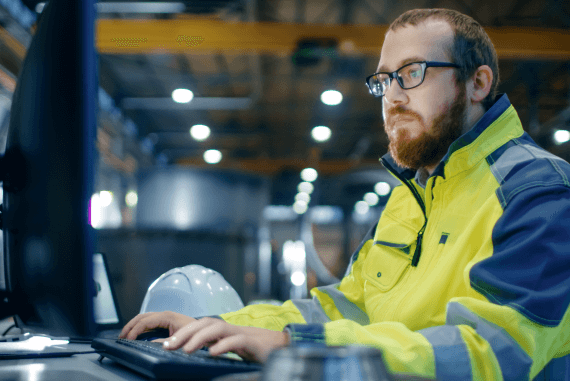- Home ››
- Health and Safety Training ››
- Articles ››
- How Can Computers Improve Health and Safety?
How Can Computers Improve Health and Safety?
Introduction

The advent of the computer age has brought with it innumerable improvements to various areas of life. Whether it is a workplace or a home, there are virtually none these days in developed countries which do not have at least one in them, and usually have multiple computers and other microprocessor devices such as mobile telephones and calculators.
The computer has also revolutionised and improved the area of health and safety in a number of different ways. Some are only slight, whereas others have had more of an impact, but even so the organisation, implementation and protection which has been enabled thanks to computer technology has resulted in the saving of lives.
So what improvements have been made?
Computer Aided Design (CAD)
Using computers to design buildings, workspace layouts, machinery etc has significantly reduced the likelihood of a design fault being responsible for a health and safety incident as any issues should be identified and corrected at the design stage. In the past, architects and designers were able to calculate with a certain degree of accuracy whether new designs were possible, but there was still quite a large element of uncertainty which could only be tested when it was actually being built. Inevitably, this brought with it the potential for collapse which could cause serious injuries and death to workers and anyone else below.
Online Health and Safety Training
Although not suitable for comprehensive health and safety qualifications like the NEBOSH Diplomas or Certificates for instance, online training courses covering a particular area such as manual handling or fire safety can provide useful information to refresh previous staff training or provide simple introductions/overviews. To see our range of online health and safety training courses click the "Online Courses" button on the right hand side of the page.
Organisation
Before computers were invented information had to either be typed out or written by hand. This meant lots of paper which could easily be mislaid, or even if it was located it could take a long time to search for the desired information. As a result, more was attempted to be done from memory or estimations, which often led to mistakes and inappropriate actions. For instance, not knowing exactly how many people are employed in a particular section of the factory could lead to an insufficient number of emergency exits and fire fighting equipment.
Automated Safety Features
Computers and electronic devices have enabled the introduction of automated safety features which can activate almost instantly and prevent incidents from taking place. Computer monitoring through electronic sensors, and the subsequent automatic safety process which activates should those sensors detect abnormal readings, is perhaps the biggest improvement in health and safety that computers and electronics have made.
Being able to close valves, shut off electricity, alter mixtures and many more actions all in fractions of a second sometimes means that potentially devastating incidents can not only be contained, but in many cases can actually be prevented entirely. Countless lives have been saved, many times without them even knowing it, because of computer technology. Not only this, but the same automated safety features have prevented numerous environmental disasters thanks to the prevention of incidents such as explosions and discharge of pollution into the air or water. For more information on environmental health and safety please click here.
Health and Safety Training in ICT
With regards to health and safety training in ICT, the main element that needs to be taken into consideration is, unsurprisingly, the computer. There are numerous risks to health associated with the use of the computer, either incorrectly or for a prolonged period of time, making it one of the major office hazards.
Workers need proper health and safety training in ICT to be aware of the dangers, along with what to do and what not to do. This is usually combined with health and safety training in other areas such as fire safety, manual handling training, sharps training etc so that staff work safely and avoid accidents and injury to themselves and others.
One of the most common health and safety issues in ICT is prolonged use of the screen. Known as display screen equipment, or DSE, using the screen without suitable breaks, or sitting too close or too far away from the screen can cause eye strain. Computer monitors should also not be located directly opposite a window, as sunlight reflecting off the screen (i.e. glare) can also be bad for the eyes.
Eye strain is not the only problem associated with using a computer though. The user must be sat in a position which is comfortable and offers sufficient support to various parts of the body. Keyboards should not be perched on the very edge of the desk, ensuring that there is sufficient space in front to rest forearms and place a wrist rest if so required.
Employers must do a risk assessment of the whole workstation, including the equipment, furniture and working environment. Where risks are identified, the employer must take steps to reduce them. The Health and Safety (Display Screen Equipment) Regulations 1992 required employers to minimise the risks of using display screen equipment. Those workers covered by the Regulations can also request that their employers provides and pays for an eye test. The Regulations do not only apply to computers, but any visual display unit that is operated by a person during the course of their work duties.
Health and safety training in ICT is also a broad term which does not necessarily mean training in relation to the actual usage of computers. It could also apply to people who set-up and maintain the equipment, and so encompasses areas such as manual handling, fire safety and environmental health and safety in terms of correct disposal of equipment which is no longer wanted.
This brief article is by no means comprehensive, and only covers a fraction of the risks and legislation involved with ICT. Our health and safety consultants can assist you with your training and assessment needs, whether it is putting a delegate(s) on a one-off health and safety training course or a series of bespoke health and safety training courses. For more information, please call us on 0844 800 3295 or contact us online using the "Contact" tab at the top of the page.

